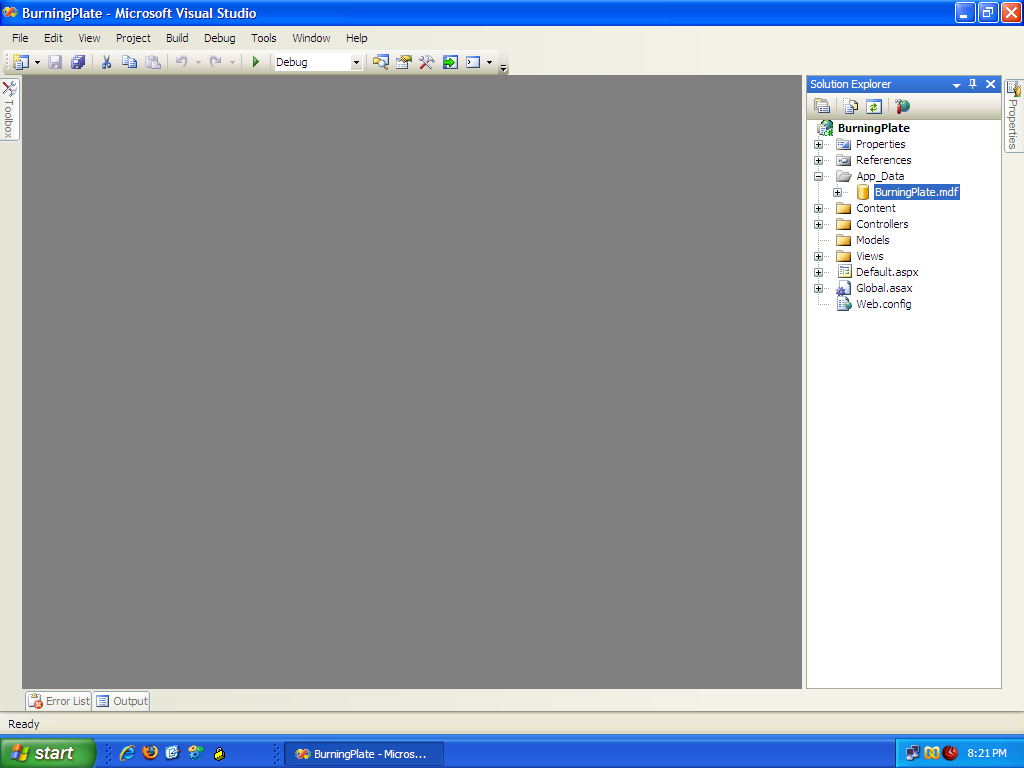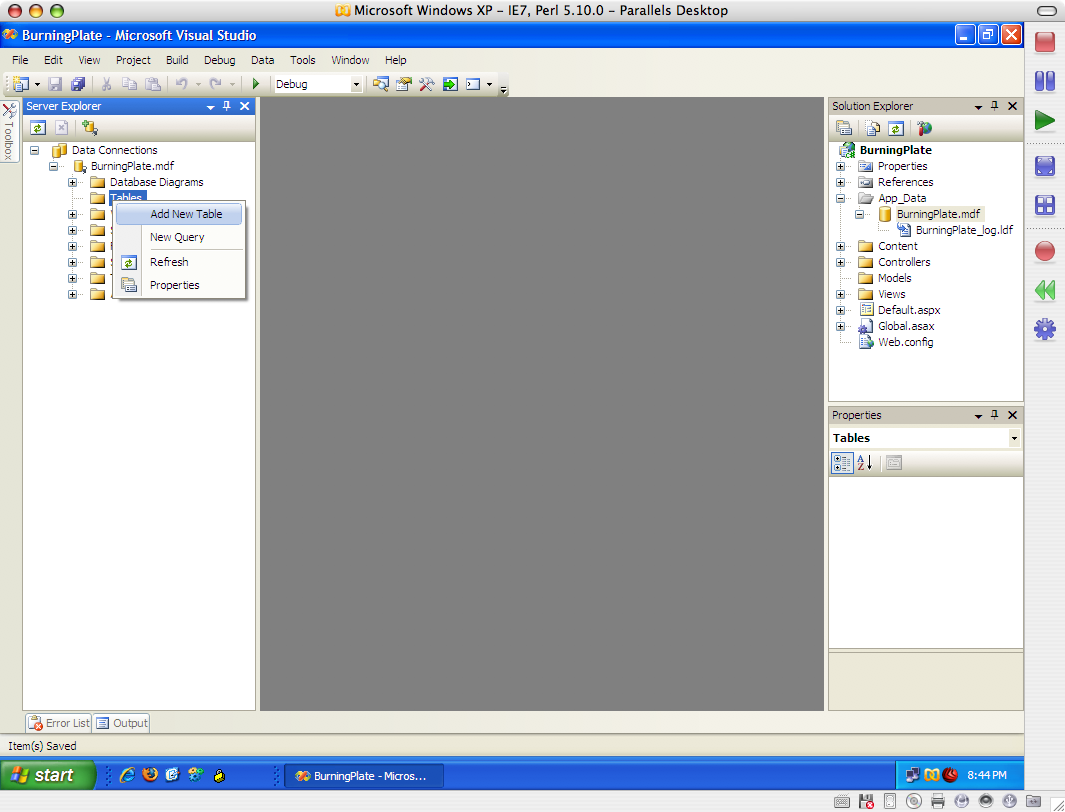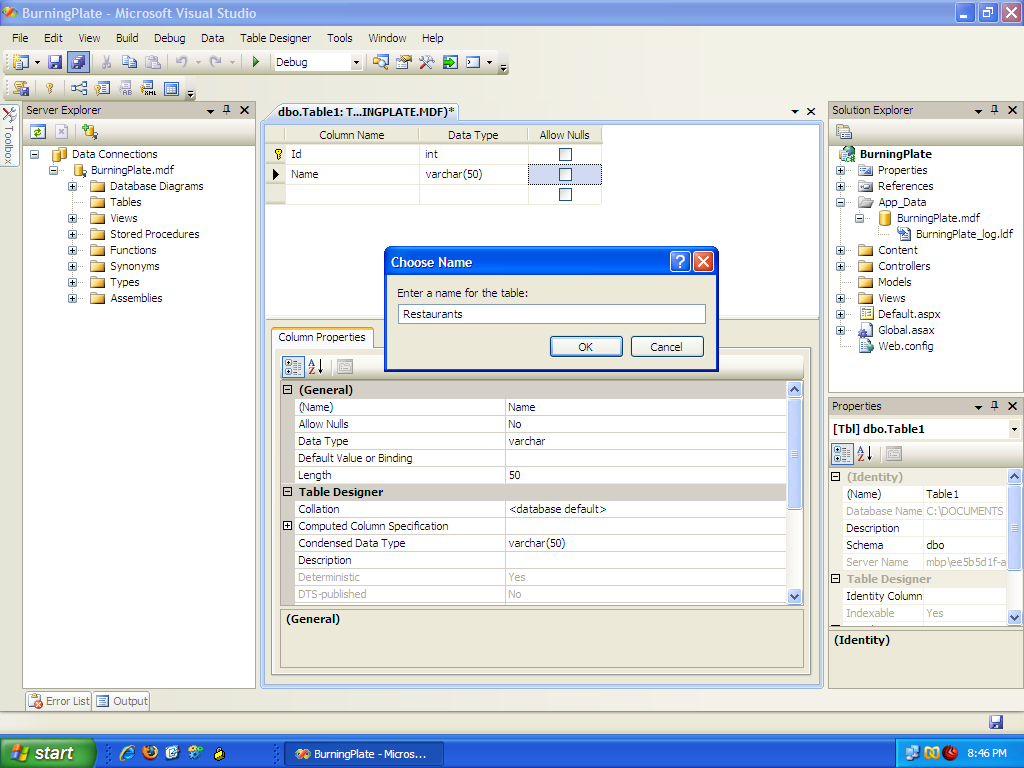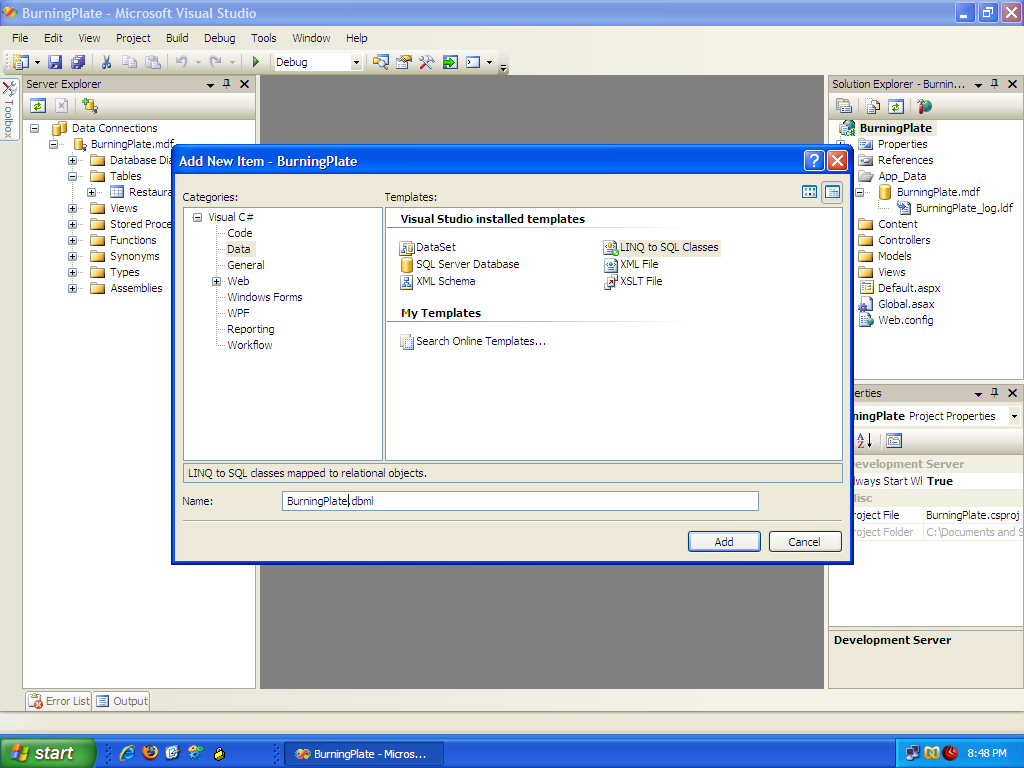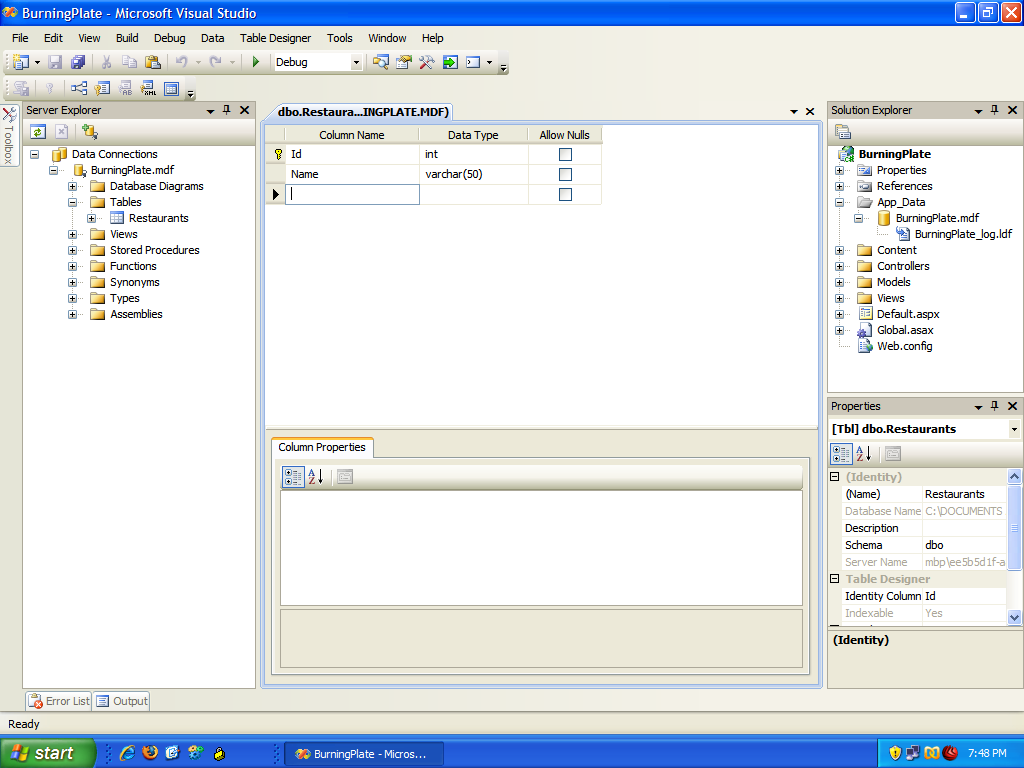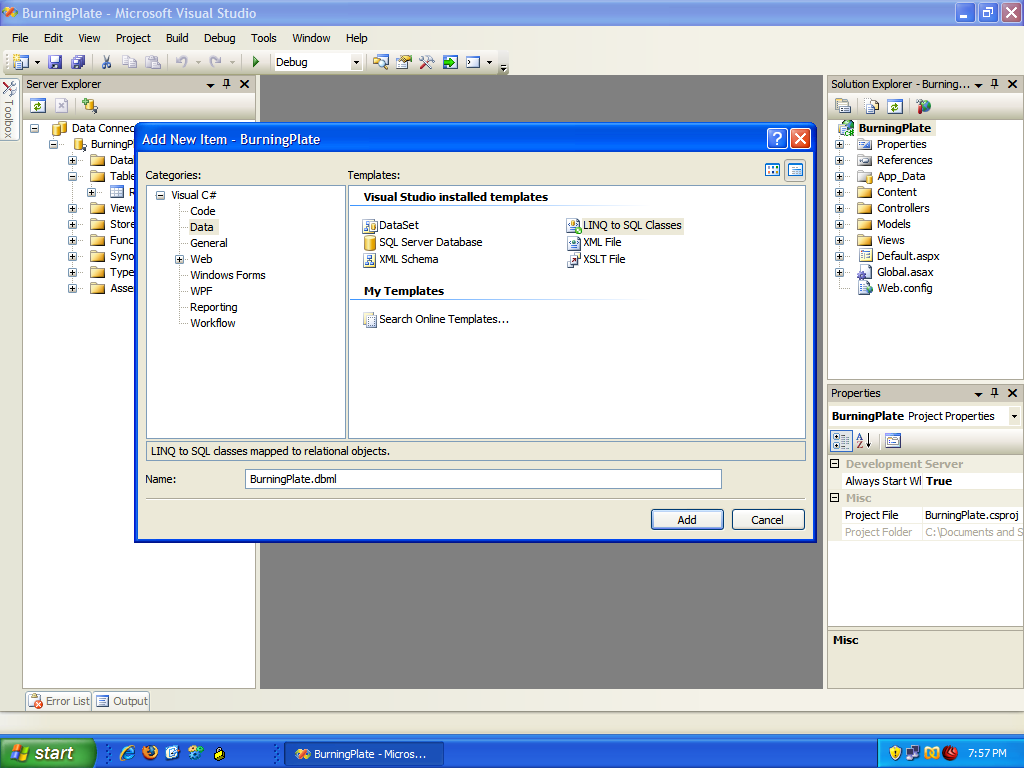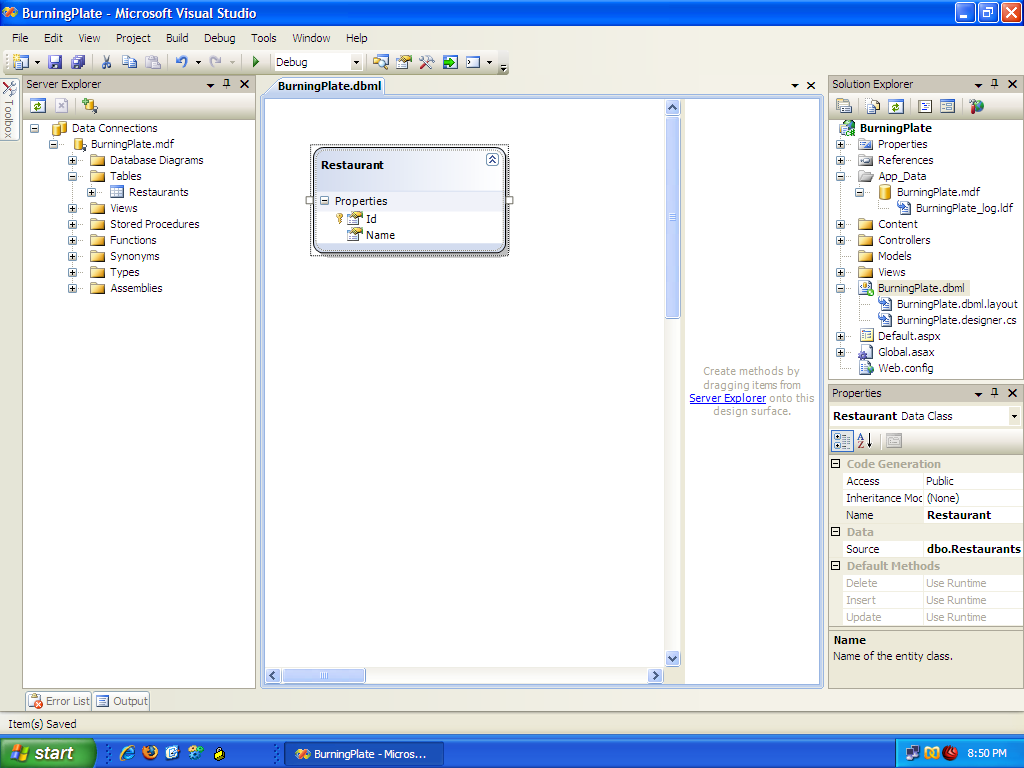Welcome to part 2 of MVC Marathon,
a multipart excursion into creating an application in the major
MVC frameworks available today.
The source code for this part can be found here:
http://github.com/claco/mvc-marathon/tree/part2/
Part 2: Creating a Database and Model
Now that we have a bunch of shiny new applications, we need to add
a database to store our data, and a model to get at the data. For
this part of the project, I’m going to try and bypass the need
to deal with mysql/postgres/mssql issues and go with the most
simple database I can: SQLite. While there is an SQLite driver
for .NET, it does not yet play well with LINQ, so in ASP.NET I’ll
be using SQL Server Express, which is part of the Studio install.
Since BurningPlate is a website about restaurants peppery hot menu
items, we’re going to need a table to hold restaurant records. For
now, the restaurants table needs only two fields: a record id and
the name of the restaurant. The id field will be an auto-increment
integer field and the name will be a 100 character field, both
disallowing nulls.
In general, there are at two distinct ways to go about creating a
new database its models.
First, all of the frameworks can simply be pointed at a database,
told the name of tables and the models will inspect the schema and
provide their own glue. In this scenario, the user is generally
expected to alter the database, and have the model follow along.
The second method is really a reverse of the first. You create
a schema in a generic language, or define your models and the
database schema is generated and/or deployed to the database from
the models themselves. Some frameworks like Ruby and Catalyst
go one step further and allow that schema to be versioned,
allowing easier upgrades/downgrades of the schema itself.
Since the second method is more exciting and offers more insight
into how the various frameworks work, that will be what I do when
the framework supports it.
Today we’ll explore how to create database and model in the
various frameworks and explore the difference between them. You
can jump to any specific framework using the links below.
ASP.NET MVC
With .NET 3.0 came LINQ, a new way to model database tables to
strongly typed classes. This new method works much like the
strongly typed datasets of old from the user perspective. Pick a
table, map it to properties, map stored procedures for actions,
then code away with strongly types classes representing your
table data.
Unfortunately, ASP.NET MVC is a database-first framework. You must
create the database and tables first. You can’t create the LINQ to
SQL classes first and then create the database/tables from the
LINQ classes. Maybe this will change with IronRuby.
Creating the Database
First, to create the database, Right-click the project file and
choose “Add New Item”. Select “SQL Server Database”. Name the new
database “BurningPlate.mdf” and click “Add”.
Studio gripes about the file type and asks us if we want to put it
it in our App_Data folder. Say “Yes” and it will. :-)
Now that we have a database, we need to create a new table.
Double-click the new database and a Server Explorer will open on
the left.
Right-click on he Tables folder and choose “Add New Table”
As we’ll see in other frameworks, LINQ to SQL classes have some
singular/pluralization (‘inflection’) naming magic to them. In our
case, a restaurants table is a collection of rows, where each row
is a restaurant. For now, lets name our table “Restaurants”.
Now that we have a new table, we’ll add our id and name columns.
We’ll follow the frameworks naming conventions and add an Id field,
setting the type to INT. We also need to set the column property
“Is Identity” below to make it an auto-increment field. Add the
Name column, setting the type to VARCHAR and change the length to
100 and click the Save button.
Creating the Model
Now that we have our database and table, we need to create the
model class to access that data. To create our new model,
Right-click the projects Models folder and select “Add New Item”.
Choose “LINQ to SQL Classes” and name it “BurningPlate.dbml”.
Now all we have to do is drag the Restaurants table from the
Server Explorer into the new BurningPlate.dbml designer window.
That’s it. We have a new database, table and model for use in
ASP.NET MVC applications. Notice how the model was given the name
“Restaurant”. That’s inflection. You can of course name your
model anything you want, and you can alter the name of the table
it points to at any time.
CakePHP
Like most other frameworks and unlike the ASP.NET MVC framework,
CakePHP can create database tables from a schema definition
using it’s own generic descriptive methods/properties to describe
tables. Before we do that, we need to continue the database
configuration that we skipped when we
created
or new CakePHP application.
To finish configuring our database information, just rerun
cake bake within our app directory.
Welcome to CakePHP v1.2.0.7296 RC2 Console --------------------------------------------------------------- App : Burningplate Path: /Users/claco/mvc-marathon/cakephp/Burningplate --------------------------------------------------------------- Your database configuration was not found. Take a moment to create one. --------------------------------------------------------------- Database Configuration: --------------------------------------------------------------- Name: [default] > Driver: (db2/firebird/mssql/mysql/mysqli/odbc/oracle/postgres/sqlite/sybase) [mysql] > sqlite Persistent Connection? (y/n) [n] > Database Host: [localhost] > Port? [n] > User: [root] > Password: > The password you supplied was empty. Use an empty password? (y/n) [n] > y Database Name: [cake] > burning_plate.db Table Prefix? [n] > Table encoding? [n] > --------------------------------------------------------------- The following database configuration will be created: --------------------------------------------------------------- Name: default Driver: sqlite Persistent: false Host: localhost User: root Pass: Database: burning_plate.db --------------------------------------------------------------- Look okay? (y/n) [y] > Do you wish to add another database configuration? [n] > Creating file /Users/claco/mvc-marathon/cakephp/Burningplate/config/database.php Wrote /Users/claco/mvc-marathon/cakephp/Burningplate/config/database.php
Note: We’ve given the database path as a
relative path. The cake command line utils consider
the root path of my app as the BurningPlate folder, but
CakePHP under Apache thinks the root path is
BurningRiver/webroot. This means when using a
relative database path, one or the other won’t find the
database. Not very portable by default. In order to fix that,
I had to add the following to the database config:
class DATABASE_CONFIG {
function __construct() {
$this->default['database'] = APP . $this->default['database'];
}
Creating the Database
Now that we’ve told CakePHP where and what database we’re
going to use, we need to create our restaurants table. Since
we’re trying to always create the tables from the models, we’ll
do that first.
CakePHP uses inflection to automagically wire up default code
and save the user as much time as possible if you
follow certain naming conventions. To create tables from
definitions, you need to create definitions in the
config/sql/schema.php file. Of course, you can also
point a model at any old table and it will work. Schemas aren’t
mandatory.
As above, we want a table that has an id integer as the primary
key and a name varchar field, both not null. Unlike ASP.NET
where we have to tell the database that the pk field was auto
and let it manage the pk auto increment, CakePHP assumes that
any integer primary key field is an auto increment field and
will manage the ids automatically. It will work as expected
even if you happen to have an existing table where the pk is
defined as auto increment. You can even use UUIDs for the
primary key just by making that field a CHAR instead. But
I digress…
class BurningPlateSchema extends CakeSchema {
public $restaurants = array(
'id' => array('type' => 'integer', 'null' => false, 'default' => NULL, 'key' => 'primary'),
'name' => array('type' => 'string', 'null' => false, 'length' => 100),
'indexes' => array('PRIMARY' => array('column' => 'id', 'unique' => 1))
);
}
Now that we have a schema defined, we need to create the table
from the schema definition. Let’s see what the command help
has to offer:
claco@mbp ~/mvc-marathon/cakephp/Burningplate $ cake schema
Welcome to CakePHP v1.2.0.7296 RC2 Console
-——————————————————————————————
App : Burningplate
Path: /Users/claco/mvc-marathon/cakephp/Burningplate
-——————————————————————————————
Cake Schema Shell
-——————————————————————————————
The Schema Shell generates a schema object from
the database and updates the database from the schema.
-——————————————————————————————
Usage: cake schema <command> <arg1> <arg2>…
-——————————————————————————————
Params: -connection <config> set db config <config>. uses 'default' if none is specified -path <dir> path <dir> to read and write schema.php. default path: /Users/claco/mvc-marathon/cakephp/Burningplate/config/sql -file <name> file <name> to read and write. default file: schema.php -s <number> snapshot <number> to use for run. -dry Perform a dry run on 'run' commands. Queries will be output to window instead of executed. -f force 'generate' to create a new schema.Commands:
schema help shows this help message. schema view read and output contents of schema file schema generate reads from 'connection' writes to 'path' To force generation of all tables into the schema, use the -f param. schema dump <filename> dump database sql based on schema file to filename in schema path. if filename is true, default will use the app directory name. schema run create <schema> <table> drop tables and create database based on schema file optional <schema> arg for selecting schema name optional <table> arg for creating only one table pass the -s param with a number to use a snapshot To see the changes, perform a dry run with the -dry param schema run update <schema> <table> alter tables based on schema file optional <schema> arg for selecting schema name. optional <table> arg for altering only one table. To use a snapshot, pass the -s param with the snapshot number To see the changes, perform a dry run with the -dry param
Now we’ll create our new table:
claco@mbp ~/mvc-marathon/cakephp/Burningplate $ cake schema run create
Welcome to CakePHP v1.2.0.7296 RC2 Console
-——————————————————————————————
App : Burningplate
Path: /Users/claco/mvc-marathon/cakephp/Burningplate
-——————————————————————————————
Cake Schema Shell
-——————————————————————————————The following tables will be dropped.
restaurantsAre you sure you want to drop the tables? (y/n)
[n] > nThe following tables will be created.
restaurantsAre you sure you want to create the tables? (y/n)
[y] > y
Creating tables.
restaurants updated.
End create.
Creating the Model
Now that we’ve created our table and database, we need to create
a model. Once again we’ll use cake bake to get the job
done.
claco@mbp ~/mvc-marathon/cakephp/Burningplate $ cake bake
Welcome to CakePHP v1.2.0.7296 RC2 Console
-——————————————————————————————
App : Burningplate
Path: /Users/claco/mvc-marathon/cakephp/Burningplate
-——————————————————————————————
Interactive Bake Shell
-——————————————————————————————
[D]atabase Configuration
[M]odel
[V]iew
©ontroller
[P]roject
[Q]uit
What would you like to Bake? (D/M/V/C/P/Q)
> M
-——————————————————————————————
Bake Model
Path: /Users/claco/mvc-marathon/cakephp/Burningplate/models/
-——————————————————————————————
Possible Models based on your current database:
1. Restaurant
Enter a number from the list above, type in the name of another model, or 'q' to exit
[q] > 1
Would you like to supply validation criteria for the fields in your model? (y/n)
[y] > n
Would you like to define model associations (hasMany, hasOne, belongsTo, etc.)? (y/n)
[y] > n
The following Model will be created:
-——————————————————————————————
Name: Restaurant
Associations:
-——————————————————————————————
Look okay? (y/n)
[y] >Baking model class for Restaurant…
Creating file /Users/claco/mvc-marathon/cakephp/Burningplate/models/restaurant.php
Wrote /Users/claco/mvc-marathon/cakephp/Burningplate/models/restaurant.php
Cake test suite not installed. Do you want to bake unit test files anyway? (y/n)
[y] > yYou can download the Cake test suite from http://cakeforge.org/projects/testsuite/
Baking test fixture for Restaurant…
Creating file /Users/claco/mvc-marathon/cakephp/Burningplate/tests/fixtures/restaurant_fixture.php
Wrote /Users/claco/mvc-marathon/cakephp/Burningplate/tests/fixtures/restaurant_fixture.phpBaking unit test for Restaurant…
Creating file /Users/claco/mvc-marathon/cakephp/Burningplate/tests/cases/models/restaurant.test.php
Wrote /Users/claco/mvc-marathon/cakephp/Burningplate/tests/cases/models/restaurant.test.php
-——————————————————————————————
Interactive Bake Shell
-——————————————————————————————
[D]atabase Configuration
[M]odel
[V]iew
©ontroller
[P]roject
[Q]uit
What would you like to Bake? (D/M/V/C/P/Q)
> Q
CakePHP simply inspected the database, asked us which table to
create a model for and created the necessary files, including
tests.
Again, take note of the inflection here. We created a table
called restaurants but the model created was Restaurant. If
you were to manually created a model called Post, it would
by default look for a table called posts. This can, of course,
be overridden using the $useTable variable.
While there is a cake console that we could use to
test out model and create a record, I couldn’t get it to work.
It could connect to the database and find records, but it
would not save a new record, even though it said
“Saved record for Restaurant”.
Catalyst
One of the Perl mantras is TIMTOWTDI: There is more than one way
to do it. As such, Catalyst doesn’t come with database support
out of the box. One reason for this is that there are more than
one ORM packages for Perl and different reasons for an author to
prefer one over the other. However, if you install the bundle
referenced in the official tutorial, it will install of the
necessary bits to do database work.
Much like CakePHP, you can have three distinct layers when using
a database in Catalyst: The models generated from the schema, the
schema describing the database and the database itself. You can
choose to statically or dynamical create the schema from the
database or do the reverse: create the database from the schema.
For this application, I’m going to use the new schema versioning
built into DBIx::Class. Like CakePHP above, we’re
going to create our schema first, deploy it to the database and
then create models from our schema.
Creating the Database
Unlike CakePHP, we need to get down and dirty with writing some
code manually to get our schema started and to maintain the
schema versions and upgrades. This isn’t as bad as it sounds.
Most of the heavy lifting is already coded for us. First, we need
to create out schema file in lib/BurningPlate/Scheme.pm
package BurningPlate::Schema;
use strict;
use warnings;
use base 'DBIx::Class::Schema';
our $VERSION = 0;PACKAGE->load_classes;
PACKAGE->load_components('+DBIx::Class::Schema::Versioned');
PACKAGE->upgrade_directory('sql/');
PACKAGE->backup_directory('sql/backups/');1;
In a nutshell, we’re telling DBIx::Class to load all
BurningPlate::Schema::* child classes, load the versioning module,
and place the schema upgrade/backup files in the given directories.
Take note of the $VERSION variable. This is used by
the versioning module to determine what version the schema is
compared to the database versioning information table.
We could create our table schema and deploy the schema to the
database. DBIx::Class currently considers any database without
a versioning table to be the current version and will not upgrade
anything even if it difference from your schema classes. Because
of this, it’s better to consider version 1 a blank database and
work up from there. We’re going to deploy what we have now before
we add the restaurants table.
DBIx::Class doesn’t come with console scripts to generate schema
versioning files or upgrade database. But because they’re simple
method calls, they’re easy enough to create. First our schema sql
script script/burningplate_schema.pl
#!/usr/bin/perl -w
use strict;
use warnings;
use FindBin;
use lib "$FindBin::Bin/../lib";
use BurningPlate::Schema;my $version = BurningPlate::Schema->schema_version;
BurningPlate::Schema->connect->create_ddl_dir(
['SQLite'],
$version > 1 ? $version : undef,
'sql',
$version ? $version-1 : $version
);
The script basically loads the schema, finds the version, then
calls create_ddl_dir to create sql ddl files from the
current schema version. If the version is greater than 1, we also
create an sql file that contains the difference between the
versions. This is the heart of schema versioning. Database changes
can be rolled out incrementally from one version to the next. We
specified SQLite, but you can create multiple schemas at the same
time for multiple database vendors.
Now, we’ll run the script to generate our version 1 ddl files.
claco@mbp ~/mvc-marathon/catalyst/BurningPlate $ script/*schema.pl
Your DB is currently unversioned. Please call upgrade on your schema to sync the DB.
Now, in our sql directory, we have a new file:
—
- Created by SQL::Translator::Producer::SQLiteCreated on Tue Jul 8 19:44:05 2008
-
—
BEGIN TRANSACTION;COMMIT;
Since we have no tables yet, we have no sql to deploy but we must
still run an upgrade to install the versioning table and the
current version number. Since we have no console script to do that
, we’ll create one in script/burningplate_upgrade.pl
#!/usr/bin/perl -w
use strict;
use warnings;
use FindBin;
use lib "$FindBin::Bin/../lib";
use BurningPlate::Schema;BurningPlate::Schema->connect(@ARGV)->upgrade;
In this script, we simply connect to the specified database and
upgrade it to the latest version. Now we can deploy our first
version and the versioning tables.
claco@mbp ~/mvc-marathon/catalyst/BurningPlate $ script/*upgrade.pl dbi:SQLite:burning_plate.db
Your DB is currently unversioned. Please call upgrade on your schema to sync the DB.
Now, let’s define our restaurants schema and deploy it to the
database. First, we need to increase the schema $VERSION to 2.
Next, we’ll create BurningPlate/Schema/Restaurant.pm
package BurningPlate::Schema::Restaurant;
use strict;
use warnings;
use base 'DBIx::Class';
PACKAGE->load_components('Core');
PACKAGE->table('restaurants');
PACKAGE->add_columns(
id => {
data_type => 'INT',
is_nullable => 0,
is_auto_increment => 1
},
name => {
data_type => 'VARCHAR',
size => 100,
is_nullable => 0
}
);
PACKAGE->set_primary_key('id');1;
Much like the CakePHP schema, we are telling the schema the
names and properties of the columns and a primary key. Now
that we have a complete schema, we need to deploy it to a
database. First, we’ll generate the version 2 sql.
claco@mbp ~/mvc-marathon/catalyst/BurningPlate $ script/*schema.pl
Now, if you look in the sql folder, we have two new files.
First, we have BurningPlate-Schema-2-SQLite.sql.
This contains the entire schema as it exists in version 2 if
we were to deploy the entire schema from scratch.
—
- Created by SQL::Translator::Producer::SQLiteCreated on Tue Jul 8 22:52:12 2008
-
-
BEGIN TRANSACTION;
-
- Table: restaurants
-
DROP TABLE restaurants;
CREATE TABLE restaurants (
id INTEGER PRIMARY KEY NOT NULL,
name VARCHAR NOT NULL
);COMMIT;
We also have a second file: BurningPlate-Schema-1-2-SQLite.sql.
This file contains all the sql necessary to upgrade a database from
version to version 2.
— Convert schema 'sql/BurningPlate-Schema-1-SQLite.sql' to 'sql/BurningPlate-Schema-2-SQLite.sql':BEGIN;
CREATE TABLE restaurants (
id INTEGER PRIMARY KEY NOT NULL,
name VARCHAR NOT NULL
);COMMIT;
Later on if we were to add a column to version 3, the 2→3 file
would contain an ALTER TABLE statement. Now, we just need to deploy
the new version to the database using the same command we ran before:
claco@mbp ~/mvc-marathon/catalyst/BurningPlate $ script/*upgrade.pl dbi:SQLite:burning_plate.db
Versions out of sync. This is 2, your database contains version 1, please call upgrade on your Schema.
The warnings are a little misleading. They’re generated by the call
to connect() which do before calling upgrade.
Creating the Model
Now that we have our schema and database, we need to create a model
to access that data. There are many ways to do this in Catalyst.
One can manually create a model and load the schema directly or
you can bypass the schema class and write database access code
to use the database directly. Let’s see what the create script
has to say:
claco@mbp ~/mvc-marathon/catalyst/BurningPlate $ script/burningplate_create.pl
Usage:
burningplate_create.pl [options] model|view|controller name [helper]
[options] Options: -force don't create a .new file where a file to be created exists -mechanize use Test::WWW::Mechanize::Catalyst for tests if available -help display this help and exits Examples: burningplate_create.pl controller My::Controller burningplate_create.pl controller My::Controller BindLex burningplate_create.pl -mechanize controller My::Controller burningplate_create.pl view My::View burningplate_create.pl view MyView TT burningplate_create.pl view TT TT burningplate_create.pl model My::Model burningplate_create.pl model SomeDB DBIC::Schema MyApp::Schema create=dynamic\ dbi:SQLite:/tmp/my.db burningplate_create.pl model AnotherDB DBIC::Schema MyApp::Schema create=static\ dbi:Pg:dbname=foo root 4321 See also: perldoc Catalyst::Manual perldoc Catalyst::Manual::Intro
The easiest way to use our schema as a model without writing code
is to use Catalyst::Model::DBIC::Schema listed above.
This will automatically load a schema class and create a model for
each table (resultsource in DBIC speak) found. To create our
model, we simply call the create script, passing in the
appropriate options:
claco@mbp ~/mvc-marathon/catalyst/BurningPlate $ script/burningplate_create.pl model DB DBIC::Schema BurningPlate::Schema dbi:SQLite:burning_plate.db
exists "/Users/claco/mvc-marathon/catalyst/BurningPlate/script/../lib/BurningPlate/Model"
exists "/Users/claco/mvc-marathon/catalyst/BurningPlate/script/../t"
created "/Users/claco/mvc-marathon/catalyst/BurningPlate/script/../lib/BurningPlate/Model/DB.pm"
created "/Users/claco/mvc-marathon/catalyst/BurningPlate/script/../t/model_DB.t"
Just like CakePHP, it generated a model file and created a test
file for us. If we reload the application, we now see that the
new model is loaded and ready for action.
[debug] Loaded components:
.————————————————————————————————--———-.
| Class | Type |
+————————————————————————————————-—————+
| BurningPlate::Controller::Root | instance |
| BurningPlate::Model::DB | instance |
| BurningPlate::Model::DB::Restaurant | class |
'————————————————————————————————-+—————'
In contrast to CakePHP, there is no inflection magic here. Name your model
and your table whatever you want without worry of breaking things
without really knowing.
Unlike CakePHP and as we’ll see later, Django and Rails, there is
no interactive console to work with your newly created models. But
there is a utility called dbicadmin that can be used to
perform CRUD operations with the schema. On the down side, the schema
doesn’t hold the database connection information; the model does. So
using the utility isn’t practical in this case without altering code.
Django
Django takes a more compact approach than CakePHP and Catalyst w/
DBIx::Class. In Django, there is no separation between models and
the schema. In fact, all of the models are defined in one single
models.py class instead of putting separate classes in a models
directory like Catalyst/CakePHP do.
Creating the Model
Creating models in Django is just a matter of creating the
models.py file. You also get a modesl.py file for free when you
run manage.py startapp, which creates a new application
sudirectory in the project we previously created. Since we’re not
really creating multiple apps right now, we’ll just create the
models.py file in the project root.
from django.db import modelsclass Restaurant(models.Model):
id = models.AutoField(primary_key=True)
name = models.CharField(max_length=100)
In the file above, we created a new Restaurant class and defined
the id and name fields. AutoField implies a code managed
(not db managed) auto increment int field, and we’ve set primary
key and the name length.
Creating the Database
Now that we have a model, we need to create a database from it.
First, we need to tell Django how to conect to the new database
by changing settinga.py
DATABASE_ENGINE = 'sqlite3' # 'postgresql_psycopg2', 'postgresql', 'mysql', 'sqlite3' or 'ado_mssql'.
DATABASE_NAME = 'burning_plate.db' # Or path to database file if using sqlite3.
While we’re in here, we need to tell this Django project that it
also should load our new BurningPlate application, which is now
only a models.py file. If we wanted to use other apps in our project,
we could just laod them here.
INSTALLED_APPS = (
'django.contrib.auth',
'django.contrib.contenttypes',
'django.contrib.sessions',
'django.contrib.sites',
'BurningPlate'
)
Now, to create our database, we just run the syncd command.
claco@mbp ~/mvc-marathon/django/BurningPlate $ python manage.py syncdb
Creating table auth_permission
Creating table auth_group
Creating table auth_user
Creating table auth_message
Creating table django_content_type
Creating table django_session
Creating table django_siteYou just installed Django's auth system, which means you don't have any superusers defined.
Would you like to create one now? (yes/no): no
Installing index for auth.Permission model
Creating table BurningPlate_restaurant
That’s all there is to it. Django created a bunch of auth related
tables and then our restaurant table. Let’s take a gander at the
schema:
CREATE TABLE "BurningPlate_restaurant" (
"id" integer NOT NULL PRIMARY KEY,
"name" varchar(100) NOT NULL
);
Django also doesn’t play any inflection games. The model name
is the table name. However, since Django projects are assumed to
have multiple apps within them, the name of the app has been
prepended to the table name to avoid name collisions. You can
override the table name using the db_table variable.
Now, let’s fire up the interactive console and test out our model.
claco@mbp ~/mvc-marathon/django/BurningPlate $ python manage.py shell
Python 2.5.1 (r251:54863, Oct 17 2007, 22:46:25)
[GCC 4.0.1 (Apple Computer, Inc. build 5367)] on darwin
Type "help", "copyright", "credits" or "license" for more information.
(InteractiveConsole)
>>> from BurningPlate .models import Restaurant
>>> Restaurant.objects.all()
[]
>>> r = Restaurant(name="Azteca")
>>> r.save()
>>> r.id
1
>>> r.name
'Azteca'
>>> Restaurant.objects.all()
[<Restaurant: Restaurant object>]
>>> quit()
Ruby on Rails
Rails has migrations which is a lot like the Catalyst/DBIx::Class
schema versioning with a little more glue around the edges to make
thing go quicker. Like CakePHP and Catalyst, the model, schema (or
migrations) and the database are three separate layers. Unlike
Django models, Rails (ActiveRecord based) models don’t describe
the schema. Instead, they operate by dynamically inspecting the
table they’re working on.
Creating the Model
Like Catalyst and CakePHP, we can use the console scripts to create
a new model and do all sorts of other things. First, let’s see what
generate tells us.
claco@mbp ~/mvc-marathon/rails/BurningPlate $ script/generate
Usage: script/generate generator [options] [args]Rails Info:
-v, —version Show the Rails version number and quit.
-h, —help Show this help message and quit.General Options:
-p, —pretend Run but do not make any changes.
-f, —force Overwrite files that already exist.
-s, —skip Skip files that already exist.
-q, —quiet Suppress normal output.
-t, —backtrace Debugging: show backtrace on errors.
-c, —svn Modify files with subversion. (Note: svn must be in path)Installed Generators
Builtin: controller, integration_test, mailer, migration, model, observer, plugin, resource, scaffold, session_migrationMore are available at http://rubyonrails.org/show/Generators
1. Download, for example, login_generator.zip
2. Unzip to directory /Users/claco/.rails/generators/login
to use the generator with all your Rails apps
or to /Users/claco/mvc-marathon/rails/BurningPlate/lib/generators/login
to use with this app only.
3. Run generate with no arguments for usage information
script/generate loginGenerator gems are also available:
1. gem search -r generator
2. gem install login_generator
3. script/generate login
Now, let’s check out the model option.
claco@mbp ~/mvc-marathon/rails/BurningPlate $ script/generate model
Usage: script/generate model ModelName [field:type, field:type]Options:
—skip-timestamps Don't add timestamps to the migration file for this model
—skip-migration Don't generate a migration file for this model
—skip-fixture Don't generation a fixture file for this modelRails Info:
-v, —version Show the Rails version number and quit.
-h, —help Show this help message and quit.General Options:
-p, —pretend Run but do not make any changes.
-f, —force Overwrite files that already exist.
-s, —skip Skip files that already exist.
-q, —quiet Suppress normal output.
-t, —backtrace Debugging: show backtrace on errors.
-c, —svn Modify files with subversion. (Note: svn must be in path)Description:
Attribute pairs are column_name:sql_type arguments specifying the model's attributes. Timestamps are added by default, so you don't have to specify them by hand as 'created_at:datetime updated_at:datetime'. You don't have to think up every attribute up front, but it helps to sketch out a few so you can start working with the model immediately. This generates a model class in app/models, a unit test in test/unit, a test fixture in test/fixtures/singular_name.yml, and a migration in db/migrate.
Stubs out a new model. Pass the model name, either CamelCased or
under_scored, and an optional list of attribute pairs as arguments.Examples:
creates an Account model, test, fixture, and migration: Model: app/models/account.rb Test: test/unit/account_test.rb Fixtures: test/fixtures/accounts.yml Migration: db/migrate/XXX_add_accounts.rb `./script/generate model post title:string body:text published:boolean` creates a Post model with a string title, text body, and published flag.
`./script/generate model account`
We could pass in our column definitions in one shot, but where’s the
fun in that? Let’s create a new model.
claco@mbp ~/mvc-marathon/rails/BurningPlate $ script/generate model Restaurant
exists app/models/
exists test/unit/
exists test/fixtures/
create app/models/restaurant.rb
create test/unit/restaurant_test.rb
create test/fixtures/restaurants.yml
create db/migrate
create db/migrate/001_create_restaurants.rb
Just like CakePHP and Catalyst, the script was kind enough to create
some test files for the new model. It also generated a migration
file for us. Let’s have a look:
class CreateRestaurants < ActiveRecord::Migration
def self.up
create_table :restaurants do |t|
t.column :name, :string, :limit=>100, :null=>false
t.timestamps
end
end def self.down drop_table :restaurants endend
Unlike DBIx::Class schema version files which are sql based,
Rails migrations are based on code. Up describes what to do when
migrating from an older version to the current version. Down
describes what to do when migrating form the current version to the
previous version. For version 1 [from 0].
Creating the Database
Now that we have our model, let’s create our database from it.
We need to use rake, Rubys make, to migrate the database.
claco@mbp ~/mvc-marathon/rails/BurningPlate $ rake db:migrate
(in /Users/claco/mvc-marathon/rails/BurningPlate)
== 1 CreateRestaurants: migrating =========
— create_table(:restaurants)
-> 0.0025s
== 1 CreateRestaurants: migrated (0.0027s) ========
Notice the table name: restaurants. Our old friend inflection is
back. We also didn’t have to setup our database connection information.
The default database.yml config already has a development
database setup in bd/development.sqlite3.
Another item of interest. If we take a look at the table that was
create, you’ll notice something that wasn’t in our model:
CREATE TABLE restaurants ("id" INTEGER PRIMARY KEY AUTOINCREMENT NOT NULL,
"name" varchar(100) NOT NULL,
"created_at" datetime DEFAULT NULL,
"updated_at" datetime DEFAULT NULL);
When Rails creates a table from a model, it always adds the id,
create_at and updated_at fields for automatically set create and
updated dates when each record is created/modified. CakePHP will
also maintain create/updated fields but it will not declare them
for you when you create the tables.
Like most of the other frameworks, you can use an interactive
console to try out your new models.
claco@mbp ~/mvc-marathon/rails/BurningPlate $ script/console
Loading development environment (Rails 2.0.2)
>> Restaurant.create(:name => 'Azteca')
=> #<Restaurant id: 1, name: "Azteca", created_at: "2008-07-08 22:29:32", updated_at: "2008-07-08 22:29:32">
>> r = Restaurant.find_by_id(1)
=> #<Restaurant id: 1, name: "Azteca", created_at: "2008-07-08 22:29:32", updated_at: "2008-07-08 22:29:32">
>> r.name
=> "Azteca"
>> quit()
Conclusions
-
Catalyst is my alma mater. Perl is my favorite language, and
I appreciate that there are many ways to do the same thing
and nothing is forced upon me. However, as DBIx::Class
is pushed in the tutorials, it is really the defacto ORM
for Catalyst. As such, there really needs to be some glue to
round off the sharp edges.If DBIC is installed or there is a command line option to request it,
catalyst should generate a Schema class,
directories for the sql versioning and a helper script or
two to help generate schema versioning files and update/deploy
them. This would go a long way to improving the new user
experience. -
The CakePHP interactive console seems to be a bit immature.
It doesn’t appear to add items, or at least my install
wasn’t very happy. The other thing I’m not sure I can
accept is that models return data, not objects.The schema management only deploys new tables. It doesn’t
deploy changes. It would be nice to see some sort of
versioning or migrations like Catalyst/Rails.The fact that the console utilities and webroot look in
two different places for a database path is a drag. It
makes things less portable, esp if you have to put in a
full path. -
Compared to Rails migrations and DBIC versioning, Django feels week
like CakePHP when it comes to syncing the model to the
database.I love that apps have been given consideration as movable
reusable parts within many projects. This is something
that is a little more obtuse in other frameworks. -
I dig Rails migrations. While I can also have custom code
when upgrading schema versions in Catalyst, migrations feel more
natural to me. I like that upgrades and downgrades feel
like they get equal attention and you can migrate to
any version by number.The magic adding of the id column and the created/updated
columns scares me a little. If I already have a created
column instead of a created_At column, well, that could
lead to issues. -
Inflections seem unnecessary to me, esp if you don’t speak
Engrish as the primary language. But, to their credit, at
least Rails and CakePHP give you control over the inflections
if you need. Good Magic is magic that can be customized. -
ASP.NET/ADO/SQL aren’t really build for versioning or for
deploying a database schema from the models. To me, this
makes deploying new versions a little more painful if you
are stuck writing your alter scripts and such. -
One of the things I like about CakePHP is that by default,
new models and controllers inherit from an app local model
and controller base class. Rails controllers also do this. This is easy to do in Catalyst,
but it’s not forced upon you by default. Maybe it should be
since I hear a lot of “use a base class” responses when
people ask about creating plugins.Ruby has more of a mixin model rather than multiple inheritance.
Personally, I’d prefer that Rails models also inherited from an
app local base class, then mixin-ed ActiveRecord on top of that.


